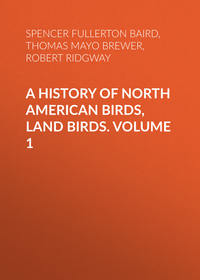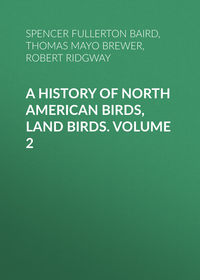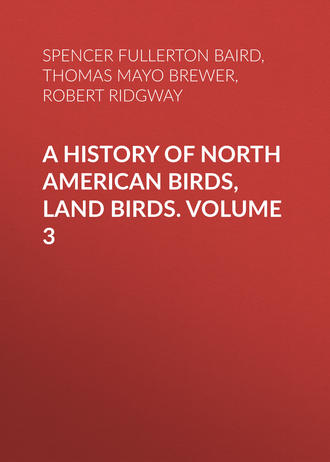 полная версия
полная версияA History of North American Birds, Land Birds. Volume 3
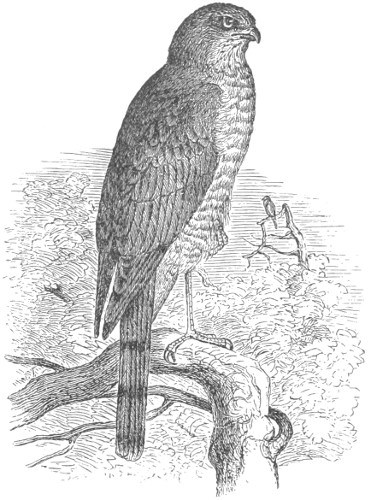
Nisus fuscus.
Dr. Woodhouse, who frequently observed this bird skimming over the prairies while in search of its prey, states that its flight is so peculiar that there is no difficulty in recognizing it, when taken in connection with its form, short wings, and long tail, being very swift and irregular in its movements, first high in the air, then close to the ground, suddenly disappearing among the grass when it has seized the object of which it was in pursuit.
Mr. Dresser met with this Hawk in Texas, but nowhere south or west of San Antonio, where it remains through the breeding-season, nesting in the dense cedar-thickets.
Mr. Audubon regarded it as the very miniature of the Goshawk, in its irregular, swift, vigorous, varied, and yet often undecided, manner of flight, and on occasion greatly protracted. When in search of its prey, it is said to pass over the country, now at a moderate height, now close over the land, and with a surprising swiftness. It advances by sudden dashes, and pounces upon the object of its pursuit so suddenly as to render hopeless any attempt to escape. It has frequently been known to seize and kill a bird so large that it was unable to carry it, and had to drop to the ground with it. In one instance Mr. Audubon saw it strike a Brown Thrush, which it had darted into a thicket of briers to seize, emerging at the opposite side. As Mr. Audubon ran up, the Hawk attempted twice to rise with its prey, but was unable to carry it off, and relinquished it. The Thrush was quite dead, and had evidently been killed instantly.
Mr. Downes, of Halifax, who speaks of this Hawk as common in Nova Scotia, breeding all over that province, adds that it does not molest the poultry-yards, being too weak to attack large prey. But this is not universally the case. They are frequently destructive both to dove-cots and to the younger inhabitants of the poultry-yard. Mr. Nuttall narrates that in the thinly settled parts of Alabama and Georgia it seemed to abound, and was very destructive to young chickens, a single one having been known to come regularly every day until it had carried off twenty or thirty. He was eyewitness to one of its acts of robbery, where, at noonday and in the near presence of the farmer, the Hawk descended and carried off one of the chickens. In another instance the same writer mentions that one of these Hawks, descending with blind eagerness upon its prey, broke through the glass of the greenhouse at the Cambridge Botanic Garden, fearlessly passed through a second glass partition, and was only brought up by a third, when it was caught, though very little injured.
At times this Hawk is seen to fly high, in a desultory manner, with quick but irregular movements of the wings, now moving in short and unequal circles, pausing to examine the objects below, and then again descending rapidly and following a course only a few feet from the ground, carefully examining each patch of small bushes in search of small birds.
Besides the smaller birds, young chickens, and pigeons, this Hawk has been known to occasionally feed on small reptiles and insects, as also upon the smaller quadrupeds.
Mr. Audubon speaks of having met with three nests of this species, and all in different situations. One was in a hole in a rock on the banks of the Ohio River; another was in the hollow of a broken branch, near Louisville, Ky., and the third in the forks of a low oak, near Henderson, Ky. In the first case, the nest was slight, and simply constructed of a few sticks and some grasses, carelessly interwoven, and about two feet from the entrance of the hole. In the second instance there was no nest whatever, but in the third the birds were engaged in the construction of an elaborate nest. The number of the eggs was four in one instance, and five in another. He describes them as almost equally rounded at both ends; their ground-color white, with a livid tinge, but scarcely discernible amid the numerous markings and blotches of reddish-chocolate with which they were irregularly covered. In a nest which was large and elaborately constructed of sticks, and contained five eggs, found by Dr. H. R. Storer in Concord, Mass., there was a single egg which nearly corresponds with this description. It is, however, the only one among many specimens that at all agrees with it. This specimen is a little more than usually elongate, and its ground-color, which is a purplish-white, is nearly concealed by its blotches of various shades of sepia-brown. In every other instance the egg is very nearly spherical, the ground-color white, and beautifully marked with large confluent blotches of sepia, varying in depth from quite a light to a very dark shade. In one, these confluent markings form a broad belt around the centre of the egg. In others, they are chiefly distributed about the larger end. The contrast between the white ground and the dark confluent dashes of brown is very striking. Except in size, the eggs of this bird bear a marked resemblance to those of the Sparrow Hawk of Europe. In a few instances, the brown markings have an intermixture of red and purple. The egg measures 1.35 by 1.15 inches.
In nearly every instance the nest of this Hawk has been constructed in trees. It is usually large in proportion to the size of the bird, and its materials are somewhat elaborately put together; it is composed chiefly of large sticks and twigs, and the whole platform is covered with a thin lining of dry leaves, mosses, grass, etc. Mr. John Krider, of Philadelphia, found a nest in New Jersey, in the vicinity of that city, which was built on the edge of a high rock.
Mr. Robert Kennicott met with the nest of this species at Fort Resolution. It was composed entirely of small dry spruce twigs, with the exception of a half-dozen small flat bits of the scaly outer bark of the spruce, laid in the bottom, and forming a sort of lining. No feathers or other softer materials were used. The nest was shallow and broad. The base was about eighteen inches in diameter, and was about eight feet from the ground. It was in a small spruce in a thick wood and on high ground. When disturbed, the female flew off a short distance; but on Mr. Kennicott’s hiding himself returned and flew near the nest, continually uttering a harsh rapid note. Near the nest were marks indicating the place where the male passed the nights perched on a dry stick near the ground.
Mr. B. R. Ross observed these birds nesting thickly along the cliffs of the Upper Slave River. They were more rare northward of Fort Simpson than F. columbarius.
Mr. William Street, of Easthampton, informs me that he has found this Hawk nesting on Mount Tom, where he has known of six of their nests in one season. In the spring of 1872 he found three nests, on the 24th and 25th of May. They contained two eggs each. One of these, on the 27th contained three eggs, of which he took one; on the 3d of June two more eggs had been laid. Two of these were taken, after which the birds deserted the nest and resorted to an old squirrel’s nest, where they had four more eggs, depositing one every third day. They arrive at Mount Tom about the 1st of May. Their nests are made entirely of sticks, larger on the outside, and smaller within. They usually build in a hemlock-tree, selecting a thick clump. They are very noisy when they are at work building their nest, and often betray their presence by their cries. The younger the pair the more noisy they are. This Hawk appears to live nearly altogether on small birds. Mr. Street mentions having found ten or twelve skeletons in a single nest of this species.
Nisus cooperi (Bonap.)Var. cooperi, BonapCOOPER’S HAWKFalco cooperi, Bonap. Am. Orn. pl. x, fig. 1, 1825; Ann. Lyc. N. Y. II, 433; Isis, 1832, 1137.—James. (Wils.) Am. Orn. IV, 1831, 3.—Peab. B. Mass. III, 78. Accipiter cooperi, Gray, List B. Brit. Mus. 38, 1844; Gen. B. fol. sp. 6.—Cass. Birds Cal. & Tex. p. 96, 1854; Birds N. Am. 1858, 16.—Sclat. Pr. Z. S. 1859, 389 (difference from A. pileatus, Max.).—Heerm. P. R. R. Rep’t, VII, 31, 1857.—Coop. & Suckl. P. R. R. Rep’t, XII, ii, 145, 1860.—Coues, Prod. Orn. Ariz. p. 7, 1866.—Dresser, Ibis, 1865, 323 (Texas).—Blakist. Ibis, III, 1861, 317.—Scl. & Salv. Ex. Orn. I, 1869, 170.—Gray, Hand List, I, 32, 1869. Astur cooperi, Jard. (Wils.) Am. Orn. III, 363, 1832.—Bonap. List, p. 5; Rev. Zool. 1850, 489; Consp. Av. 31.—De Kay, Zoöl. N. Y. II, 18, pl. iv, p. 5.—Newb. P. R. R. Rep’t, VI, iv, 74, 1857.—Max. Cab. Journ. VI, 1858, 13. Falco stanleyi, Aud. B. Am. pls. xxxvi, cxli; Orn. Biog. I, 186. Accipiter pileatus (not of Max.!), Strickl. Orn. Syn. I, 109, 1855. Accipiter cooperi, Brewer, Oölogy, 1857, 20, pl. v, f. 55.
Sp. Char. Adult male (No. 10,086). Forehead, crown, and occiput blackish-plumbeous; the latter snowy-white beneath the surface; rest of upper parts slaty-plumbeous, the nape abruptly lighter than the occiput; feathers of the nape, back, scapulars, and rump with darker shaft-lines; scapulars with concealed cordate and circular spots of white; upper tail-coverts sharply tipped with white. Tail more brownish than the rump, sharply tipped with pure white, and crossed with three broad, sharply defined bands of black, the first of which is concealed, the last much broadest; that portion of the shaft between the two exposed black bands white. Lores grayish; cheeks and throat white, with fine, hair-like shaft-streaks of blackish; ear-coverts and sides of neck more ashy, and more faintly streaked. Ground-color beneath pure white; but with detached transverse bars of rich vinaceous-rufous, crossing the jugulum, breast, sides, flanks, abdomen, and tibiæ; the white bars everywhere (except on sides of the breast) rather exceeding the rufous in width; all the feathers (except tibial plumes) with distinct black shaft-lines; lower tail-coverts immaculate, pure white. Lining of the wing white, with numerous cordate spots of rufous; coverts with transverse blackish bars; under side of primaries silvery-white, purest basally (tips dusky), crossed with quadrate bars of dusky, of which there are six (the first only indicated) upon the longest quill (fourth). Wing, 9.20; tail, 7.80; tarsus, 2.35; middle toe, 1.60. Fourth quill longest; third shorter than fifth; second intermediate between sixth and seventh; first, 2.80 shorter than longest; graduation of tail, 1.00.
Adult female (26,588, Washington, D. C.; Elliott Coues). Similar to the male. Forehead tinged with brownish; upper plumage much less bluish. Neck and ear-coverts uniformly rufous, with black shaft-streaks, there being no ashy wash as in the male. Tail decidedly less bluish than in the male, crossed with four bands, three of which are exposed. The rufous bars beneath less vinaceous than in the male, but of about the same amount, rather predominating on the tibiæ. Wing, 10.70; tail, 9.00; tarsus, 2.45; middle toe, 1.80. Fourth and fifth quills longest and equal; third longer than sixth; second intermediate between sixth and seventh; first three inches shorter than longest.
Young male (55,498, Fort Macon, N. C., February; Dr. Coues). Above grayish-umber; feathers of forehead, crown, and nape faintly edged laterally with pale rusty; occiput unvaried blackish, feathers white beneath the surface. Wing-coverts, scapulars, and interscapulars narrowly bordered with pale yellowish-umber; rump and upper tail-coverts bordered with rusty. Tail paler umber than the back, narrowly tipped with white, and crossed by four bands of brownish-black, the first of which is only partially concealed. Scapulars and upper tail-coverts showing much concealed white, in form of roundish spots, on both webs. Beneath clear white, without any yellowish tinge; throat with a medial and lateral series of clear dark-brown streaks; jugulum, breast, sides, flanks, and abdomen with numerous stripes of clear sepia, each showing a darker shaft-streak; tibiæ with longitudinal streaks of paler and more rusty brown; lower tail-coverts immaculate.
Young female (6,876 “Sacramento Valley, Cal.”; Dr. Heermann—probably from Pennsylvania). Similar to young male; more varied, however. The black middle streaks of feathers of head above narrower, causing more conspicuous streaks; white spots of scapular region considerably exposed; longitudinal stripe beneath narrower and more sparse.
Hab. North America in general, but rare in the western division; Eastern Mexico. Not found in West Indies, where replaced by A. gundlachi, Lawr.
Localities: Southeastern Texas (Dresser, Ibis, 1865, 323, breeds); Arizona (Coues, Prod. 1866, 43); Costa Rica (Lawr. IX, 134).
LIST OF SPECIMENS EXAMINEDNational Museum, 12; Philadelphia Academy, 16; New York Museum, 3; Boston Society, 2; Cambridge Museum, 1; Cab. G. N. Lawrence, 7; Coll. R. Ridgway, 4; Museum, W. S. Brewer, 1. Total, 46.

Accipiter mexicanus, Swains. F. Bor.-Am. II, 1831, 45.—Jard. (ed. Wils.) Am. Orn. II, 1832, 215.—Bonap. Consp. 32 (under A. fuscus).—Cass. B. Cal. & Tex. 96.—Ib. P. A. N. S. 1855, 279; Birds N. Am. 1858, 17.—Coop. & Suckl. P. R. R. Rep’t, VII, ii, 1860, 146.—Coues, P. A. N. S. Philad. 1866, 18.—Gray, Hand List, I, 1869, 33.
Adult male (12,024, Fort Tejon, Cal.; J. Xantus). Forehead, crown, and occiput plumbeous-black, feathers of the latter with basal two-thirds snowy-white, partially exposed. Upper plumage deep plumbeous, darkest anteriorly, the back being scarcely lighter than the nape; rump fine bluish-plumbeous. No concealed white on the upper parts. Tail brownish-plumbeous, narrowly tipped with pure white, and with four sharply defined broad bands of black,—the first of which is faintest, and concealed by the coverts, the last broadest; shafts of tail-feathers deep brown throughout. Primaries and secondaries much darker than the tail, more bluish; less so, however, than the scapulars. Lores whitish, quite in contrast with the black of the forehead; cheeks and ear-coverts dark ashy, slightly washed with reddish, and with obscure darker streaks; chin and throat white, with sparse hair-like shaft-streaks of black. Breast, abdomen, sides, flanks, and tibiæ fine vinaceous-rufous; feathers (except on tibiæ) with fine hair-like shaft-streaks of black (much narrower than in cooperi); breast, abdomen, sides, and flanks with pairs of transverse ovoid white spots, not touching the shaft; on the abdomen the white and rufous bars are of about equal width; on the tibiæ the rufous is deepest, and exceeds the white; anal region barred with rufous, more faintly than the abdomen; lower tail-coverts snowy-white. Sides of the neck deep reddish-ashy, this washing the whole side of the breast. Lining of the wing reddish-white, with numerous crowded, cordate, somewhat blended spots of rufous; larger coverts transversely spotted with blackish; under side of primaries silvery-white (blackish for about the terminal inch), crossed with quadrate spots of blackish, of which there are about seven on the longest quill (fourth); the basal ones are, however, so much broken, that the number varies in different individuals.
Young male (Fort Tejon, California). Forehead, crown, occiput, and nape deep rusty-rufous; feathers with broad longitudinal streaks of pure black. Rest of upper parts deep umber, darkest on the back; feathers of back and rump, the upper tail-coverts, scapulars, and wing-coverts, broadly bordered with rusty; scapulars with concealed white spots. Tail ashy-umber, tipped (more broadly than in adult) with ashy-white, crossed by four broad bands of brownish-black; the last (or subterminal) of which is broadest, the first concealed by the coverts. Secondaries and primaries similar in color to the tail, but darker; the first showing five obsolete darker bands, and tipped (rather broadly) with pale cinnamon-rufous. Ear-coverts and cheeks fulvous-white, thickly streaked with dark brown. Lower parts white, washed with ochraceous on jugulum and breast; each feather with a central longitudinal lanceolate stripe of clear umber, the shaft of each black; these streaks are very narrow on the throat, broadest on the breast and flanks. Tibiæ with transversely ovate spots, and transverse bars of reddish-umber; lower tail-coverts with narrow shaft-streaks of darker brown. Lining of wing with cordate and ovate spots of dark brown.
Young female (42,136, Orizaba, Mexico; M. Botteri). Similar to the young male; feathers of back, etc., less broadly margined with rusty. Ochraceous wash on lower parts more decided; stripes beneath broader and less lanceolate; on the sides broadly ovate, and on the flanks in form of broad transverse bars; tibiæ more thickly spotted transversely; lower tail-coverts immaculate. Wing, 9.00; tail, 7.80; tarsus, 2.25; middle toe, 2.50. Fourth quill longest; third shorter than fifth; second intermediate between sixth and seventh; first, 2.90 shorter than longest. Graduation of tail, .90.
Hab. Western region of North America; Mexico.
LIST OF SPECIMENS EXAMINEDNational Museum, 22; Boston Society, 2; Museum, Cambridge, 2; Cab. G. N. Lawrence, 2; Philadelphia Academy, 2; Coll. R. Ridgway, 2. Total, 32.

Habits. This common Hawk appears to have a very general distribution over the United States, from South Carolina to New Brunswick, on the Atlantic; from Texas, New Mexico, and Arizona, in the interior, to the Saskatchewan, and from Southern California to Washington Territory, on the Pacific. Mr. Boardman mentions it as found near Calais, but rare. Mr. Verrill cites it as occurring in Western Maine, but not common. I have received its eggs from South Carolina, where it is resident throughout the year. Mr. Dresser met with it not uncommon near San Antonio, and found it breeding on the Altascosa and Medina Rivers. Dr. Coues says it is generally distributed throughout the Territory of Arizona. Dr. Newberry found it common about San Francisco, and extending north of the Columbia River. Mr. A. Schott obtained a specimen on the Colorado River in Southern California, and Dr. Gambel and Dr. A. L. Heermann speak of it as common throughout that State, while Dr. Cooper and Dr. Suckley mention it as frequent both in Oregon and in Washington Territory. A single specimen was taken by Mr. Salvin in Guatemala. Dr. Cooper states that this Hawk is often killed about the farm-yards of Washington Territory, where it seizes on chickens before the very eyes of the owner, darting down like lightning, and disappearing again before he can see what has caused the disturbance. It is said to be a constant resident, and to breed within the Territory.
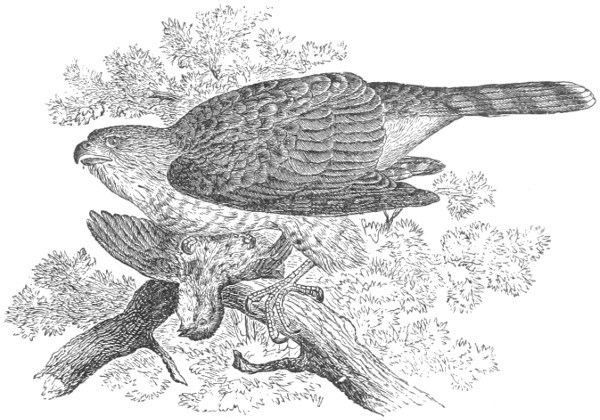
Nisus cooperi.
Mr. Audubon describes the flight of this Hawk as rapid, protracted, and even, and as performed at a short distance from the ground, or over the forest. It is said to move along in a silent gliding manner, and with a swiftness even superior to that of the Wild Pigeon, rarely deviating from a straight course except to seize its prey, and seldom mounting in the air in circles. It is very bold and daring, Mr. Audubon having known one to attack and kill a cock much larger and heavier than itself. It frequently attacks and kills the common Ruffed Grouse. It breeds in especial abundance in the Middle States, and particularly along the banks of the Potomac River. I have received reliable information of its nesting in Vermont, Massachusetts, Ohio, Illinois, Wisconsin, Maryland, Virginia, and South Carolina, and probably nearly all of the States. Mr. Gosse did not meet with it in Jamaica.
Mr. Audubon states that he found its nest usually placed in the forks of the branch of an oak-tree, towards its extremity. In general appearance it resembles that of the common Crow, being composed externally of numerous crooked sticks, and having a slight lining of grasses and a few feathers. The eggs he describes as three or four in number, almost globular, large for the size of the bird, of a dull white color, granulated and rough to the touch.
Dr. Hoy, in a communication to the Boston Natural History Society, mentions finding four nests of this Hawk in a single season, and his careful observations of the habits of the parent birds enabled him to ascertain that in each instance the birds began to sit constantly upon their nest as soon as a single egg had been deposited, and that, as a consequence, the eggs having been deposited at varying intervals, each one was found in a different stage of incubation from the other. In not a single instance did he visit a nest without finding the parent bird occupying it.
These nests were all composed of sticks, rudely lined with strips of bark and a few bunches of Usnea barbata. The nests were quite shallow and small for a Hawk. Most of the eggs were sparingly sprinkled with umber-brown. One set of these eggs was blotched with bluish-green, which soon faded out. While the nests were being molested, the parent Hawk would fly from tree to tree, uttering, in rapid succession, quick-quick-quick-quick.
Dr. Hoy states that the male of this species, during the nesting-season, may frequently be seen flying high in the air, sporting, vaulting, and turning somersaults on the wing, which habit has given to it the name of Tumbler-Hawk. No Hawk is harder to shoot, and none commits greater havoc among barn-yard fowls than this species. He has seen one strike a large hen while she was flying wildly for safety, and kill her on the spot, though it was obliged to abandon the game, as it proved too heavy to carry off.
I have specimens of its eggs from South Carolina, obtained by the young sons of Rev. M. A. Curtis, of Society Hill. Mr. Curtis, Sen., furnished me with the following description of its nest: “The nest of the Cooper’s Hawk was built in the triple fork of a tall black gum (Nyssa multiflora), near the top of the tree, which stood in a swamp. It was formed of a layer of small sticks, ⅓ to ½ inch in diameter. Its external diameter varied from 1½ to 2 feet. This layer was ⅞ of an inch in thickness, with only a slight depression in the centre, hardly enough to keep the eggs from rolling out. A few thin pieces of pine bark formed the bed for the eggs.”
Another nest, obtained in Randolph, Vt., by Charles S. Paine, Esq., is thus described by him: “The nest was built of hemlock twigs, and lined with small, thin pieces of hemlock bark, such as hang loosely on the tree. The Hawk, when the nest was approached, did not whistle, as some others of that family do, but uttered a cry of ge! ge! ge! ge! This was repeated several times, with great rapidity, by both male and female.”
The average size of the eggs of this bird is 1.56 by 1.94 inches. The color is usually a uniform dull white, but is occasionally tinged with as light bluish shade. They are nearly spherical, though not more so than the eggs of several species, and are equal at either end. Their surface is slightly granulated. The number of the eggs varies from three to four, though occasionally there are five in a nest.
The maximum length of the egg of this species is 2.00 inches, the minimum 1.85; the maximum breadth 1.60, the minimum 1.50 inches. In occasional instances I have known the eggs of this species more or less distinctly marked, especially about the larger end, with blotches of a light yellowish-brown. Those most distinctly marked in this manner were taken and identified by Mr. Paine.
A nest of this Hawk, found by Dr. J. W. Velie, was built on a poplar-tree, about forty feet from the ground, and was composed of sticks and lined with moss and leaves. There was a small cleared space of three or four rods in extent, in the middle of which the tree stood, and about a quarter of a mile from the main channel of the Mississippi River, on Rock Island.
The Cooper Hawk was found on Mount Tom by Mr. William Street, nesting for the most part in pine or hemlock trees, usually choosing one in a thick clump. They begin to lay about the first of May, usually depositing four eggs. They are very shy, and it is almost impossible to get within shot of them, even when they have young. They rarely molest the poultry-yard, but seem to live chiefly on small birds and animals. They leave their nest at once whenever it is approached, and will not return until the intruder has gone.


